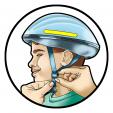
Do you remember how you learned to ride a bike? For many, it was a figure-it-out-yourself approach. But now there are many resources to help everyone learn — or relearn — to bike safely.
Rules of the Road
We can all learn a thing or two from these pre-K students when it comes to bike safety.
First, start with the basics. Understand the road is a shared space and bicyclists should follow the same rules and responsibilities as drivers:
- Ride in a straight line, single file, in the same direction as traffic.
- Obey all traffic signs and signals.
- Stop and look left-right-left for traffic before entering a street.
- Bikers should use bike lanes whenever available.

Before heading out on the road for the first time, or if it’s been a while since your last bike ride, practice in a safe area. In some areas, traffic gardens are available. Communities and schools have worked with designers to turn playgrounds and lots into miniature street networks so children can learn to navigate and use streets, in a comfortable space that’s free of cars. A goal of traffic gardens is to teach children about road safety so that they become an adult who truly understands how streets work — and how to be safe on them.
Traffic Garden
Children have the opportunity to learn how streets work, but in a controlled environment.
Maybe it’s time we rethink the phrase, “It’s like riding a bike”? It’s often used to describe a task that’s easy to accomplish if you learned it once. But what happens if you never learned the correct way to ride a bike? Well, it’s never too late to relearn. Here are some more tips.
Check your bike.
- Tires should be properly inflated.
- Brakes should be checked before you get on your bike.
Be visible.
- Wear bright colors, reflective materials at night and in low light conditions.
- Make sure your reflector is visible, and consider adding a light to your bicycle. Learn more (PDF)
Bicycle Safety
Get more information and resources.
